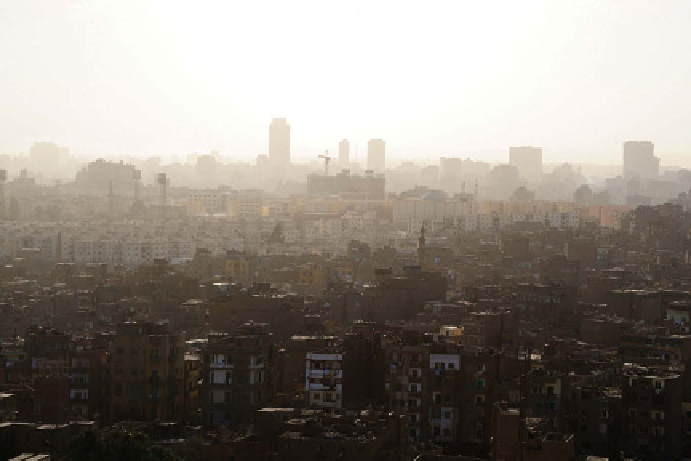Geoscience Reference
In-Depth Information
Figure 8.8.
Downtown Cairo, Egypt, February 15, 2009.
C
Jakezc/Dreamstime.com.
standards under the law were set for CO(g), NO
x
(g),
SO
2
(g), O
3
(g), and PM
10
.
of Iran. Vehicles are estimated to cause 75 to 80 per-
cent of air pollution in its capital city, Tehran. Iran has
more than 12 million cars and 7 million motorcycles.
More than 30 percent of motor vehicles use roads in
or near Tehran. The road infrastructure in Tehran was
not designed for the number of vehicles used in the
city. Iran's vehicle fleet is aged and thus highly pol-
luting. Pollution in Tehran is also exacerbated by the
fact that the city is bounded by mountains to the north,
which slow the winds, particularly when a large-scale
subsidence inversion is present. Tehran's air pollution
is among the worst in the world.
Tehran's strategy for reducing air pollution has been
through command and control and improved public
transportation. The city, for example, designated a
required green space of 10 square meters per person
in 1993. It also converted many diesel buses to nat-
ural gas buses, implemented vehicle inspection rules,
encouraged the use of electric bicycles, and expanded
its subway and bus fleet.
Nevertheless, smog events in Tehran are so severe
that they have frequently forced closures of schools and
government offices, including twice in late 2010. Res-
piratory illness in Tehran, in particular, has increased
substantially with the growth of the city and the slow
pace of air pollution abatement.
8.2.7. Egypt
Air pollution in Egypt is regulated under Law No. 4
of 1994. This law set maximum permissible emission
limits for gases and particles from industries, vehicles,
and open burning. It also established ambient air quality
limits for CO(g), SO
2
(g), NO
2
(g), O
3
(g), lead, total
suspended particles, black smoke, and PM
10
.
Egypt's most severe air pollution is in its capital,
Cairo (Figure 8.8), which houses one-fourth of the
country's population. Cairo is one of the most polluted
cities in the world. This is due in part to the large number
of vehicles, many of which are old, with poor control
devices. About 4.5 million vehicles operate in Cairo,
of which half are passenger vehicles, about 20 percent
are trucks and trailers, 16 percent are motorcycles, and
8 percent are taxis. Air pollution in Cairo is also exac-
erbated by unregistered copper smelters and the open
burning of trash and waste. The WHO indicates that
concentrations of air pollutants, mainly particulate mat-
ter, are often up to 100 times above safe limits in Cairo.
8.2.8. Iran
Iran has severe air pollution problems, primarily due
to its vehicular traffic and coal combustion. Gasoline
is the most common motor vehicle fuel used in Iran
because it is inexpensive, and oil is a domestic product
8.2.9. India
India is the second most populous country in the world
after China. The rapid population growth in India, from


Search WWH ::

Custom Search